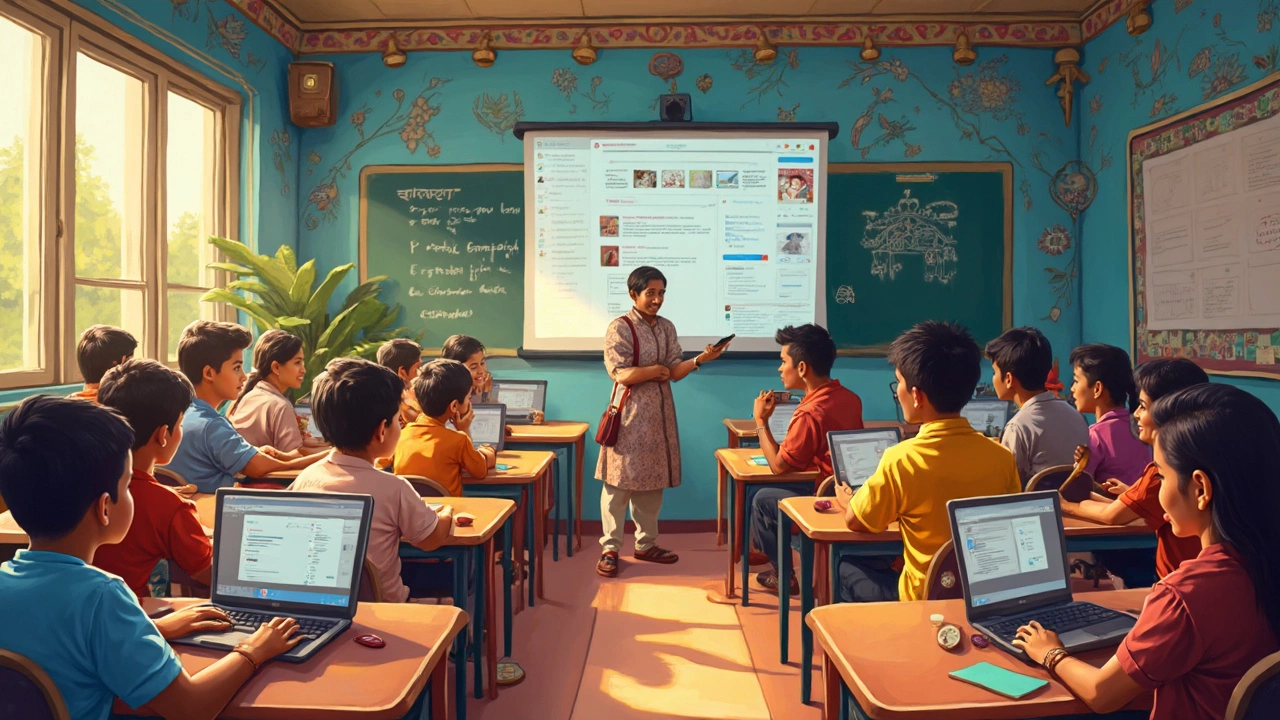So, is Google an e-learning platform? Well, not exactly, but it could be your best mate in learning if you use it right. Think of Google as more of an enabler than a traditional e-learning space. You've got Google Classroom, perfect for teachers organizing their students' work, and YouTube, where you can find tutorials on just about anything.
Google might not be the usual structured platform with courses and grades, but it rocks when offering resources and organization tools. If you're a teacher or a student looking to make online learning more streamlined, exploring Google's array of services might be your way forward. Plus, these tools are often free, which is super handy!
- Defining E-Learning Platforms
- Google's Educational Tools
- Benefits of Using Google for Learning
- How Educators Can Leverage Google Tools
- Is Google Enough for Comprehensive Learning?
Defining E-Learning Platforms
Alright, so let's clear up what exactly we mean by an e-learning platform. Picture it as an online space where learners and educators come together. It's all about providing courses, materials, and sometimes even live instruction. We're talking about stuff like Coursera, Udemy, or Khan Academy—these are examples of places you'd go to find structured lessons and classes.
Most e-learning platforms share a few common features. You usually get access to course materials, modules, and sometimes interactive assignments. Some even offer certification upon completing a course! These platforms are designed to give a full-on learning experience. They host content, track progress, and facilitate assessments.
The Core Features of E-Learning Platforms
- Course Content: Rich materials including videos, quizzes, and reading materials.
- Access & Flexibility: Learn anytime, anywhere, as long as you have the internet.
- Community & Support: Engage with peers, join forums, or even contact instructors.
- Tracking Progress: Keep tabs on your achievements and areas that need improvement.
In summary, an e-learning platform is like the digital classroom of today. It lays everything out for you, making it easier to dive into learning without the hassle of finding and organizing every material yourself. Pretty neat, right?
Google's Educational Tools
Ever thought about how much Google can offer in the education world? It's not just about searching or watching videos. Google’s ecosystem includes a bunch of tools that educators and learners can turn into a treasure trove for learning. Here’s a peek at some of the best ones.
Google Classroom
If you've ever taught a class, you know how tricky it can be to keep everything organized. Enter Google Classroom. It’s a free service that helps teachers manage classroom tasks digitally. You can create assignments, communicate with students, and keep all materials in one place.
YouTube Education
YouTube might be known for cat videos, but it's also packed with educational content. Think Harvard lectures, DIY tutorials, language lessons—it's all there. According to a 2023 study by the Pew Research Center, 87% of young adults use YouTube to learn something new every month.
"YouTube has become a vital platform for learners worldwide," says Professor Mark Hamilton, an expert in digital education. "Its scope and accessibility make it an unparalleled resource for knowledge-seekers."
Google Workspace for Education
Then there's Google Workspace for Education, which includes Gmail, Docs, Drive, and more. Perfect for collaboration, group projects become way less of a hassle. Students and teachers can jointly edit documents, spreadsheets, and presentations in real-time, making interactions smoother.
Google Scholar
For those diving deep into research, Google Scholar helps find academic papers and articles. It's like having a library at your fingertips. You can search by author, title, and even topic, making it easy to find and cite sources in your work.
Google Forms and Surveys
Ever needed feedback on a topic, or wanted to quiz your students? Google Forms makes this as easy as pie. Create surveys or quizzes, and the responses can be seamlessly organized in Google Sheets. Perfect for keeping track of data, it’s a nifty tool for interactive learning.
| Tool | Key Feature | Benefit |
|---|---|---|
| Google Classroom | Organizes assignments | Simplifies workflow |
| YouTube Education | Vast video resources | Easy access to lectures |
| Google Scholar | Search for papers | Supports research |
In a nutshell, while Google might not be a traditional e-learning platform, its tools offer endless possibilities to enhance the learning experience. Make the most of them, and learning can become more engaging and efficient.

Benefits of Using Google for Learning
When it comes to using Google for learning, the big win is accessibility. Everyone, from teachers to students, can use these tools without any cost, making education more inclusive and affordable. That's huge if you're on a budget but still want top-notch resources.
Google Classroom is a shining example of how educators can manage coursework easily. It helps with assignments, announcements, and organizing class materials. Plus, it seamlessly integrates with other apps like Google Docs and Google Sheets, so teamwork becomes a breeze. You can share documents, collaborate in real time, and watch productivity soar.
Resource-Rich Ecosystem
Another perk? The wealth of information available through Google's search engine and platforms like YouTube. Want to learn a new skill? Check out comprehensive video tutorials or a library of instructional blogs. And, since YouTube has educational channels on the rise, there's never a shortage of free content to binge on.
Data and Analytics
Using Google’s tools also means you’ve got access to data insights. Teachers can track student progress and identify areas for improvement, thanks to analytics features within certain apps. These insights can tailor learning experiences, making education more personalized and effective.
Easy Collaboration
Group projects get less stressful with Google’s collaborative tools. With shared Google Docs and Sheets, multiple users can work on the same document simultaneously—no more emailing versions back and forth. You can leave feedback, suggest edits, or just brainstorm ideas live.
Wide Adoption and Familiarity
Most people are already familiar with using Google's products, making the learning curve notably less steep. It's comforting knowing you don't have to learn a completely new system; instead, you can dive straight into the learning content.
How Educators Can Leverage Google Tools
When it comes to using Google for e-learning, educators have a treasure trove of resources at their fingertips. With a bit of creativity and organization, these tools can be pivotal in engaging students and streamlining the teaching process.
Google Classroom
First up, let's talk about Google Classroom. It's a free and easy way for teachers to distribute assignments, track progress, and create a collaborative environment. You can bulk-announce upcoming assignments or individual feedback through its streamlined communication channels.
YouTube for Education
Next on the list is YouTube, which is packed with educational channels. Educators can curate playlists tailored to their syllabus and share these with their students. It's a great way to supplement textbooks with engaging video content that aligns with today's visual learning trends.
Google Forms and Sheets
Now, if you're collecting data or running quizzes, Google Forms can be your best friend. It's not just about simple surveys—it can also power up assessments and polls, right down to marking them automatically if set up correctly.
Collaborative Learning with Google Docs
Google Docs allows real-time collaboration, making group projects and peer reviews much easier. Students and educators can work simultaneously on a document, track changes, and even revert to past versions—no more lost work!
Statistics on Google Tools in Education
| Tool | Usage Percentage |
|---|---|
| Google Classroom | 65% |
| Google Docs | 58% |
| Google Forms | 46% |
According to recent data, Google Classroom is used by about 65% of teachers worldwide for managing classes, and that's a testament to its effectiveness. Meanwhile, Google Docs and Google Forms have impactful roles in homework submission and assessments, with 58% and 46% usage, respectively.
So if you're an educator keen to dive into the digital world of teaching, integrating these Google tools into your daily routine can make a significant difference. The best part? Most of these tools are free, requiring only a Google account to access—making them an affordable and practical choice for all educators.

Is Google Enough for Comprehensive Learning?
So, you're probably wondering if Google can cover all the bases when it comes to learning. Here's the deal: while Google has some amazing tools—like Google Classroom and YouTube—it's not a one-stop shop for everything educational. These tools are great for organization, finding resources, and even hosting classes, but they don't necessarily provide a full-on curriculum.
Google's strength lies in its flexibility. You can use Google tools to supplement other learning platforms. Imagine using Google Docs for collaborative projects or Google Sheets for managing data in a science class. Yet you'll still need traditional education methods or other platforms for structured learning pathways.
What Google Offers
Google Search itself is a treasure trove of information. But be careful—quality varies, and you'll need to vet sources properly. For learning languages or historical events, Google Search can connect you with credible sources. Yet it won't do the structured work of tracking your progress like a dedicated e-learning platform might.
The Gaps
There are some areas where Google simply isn’t enough on its own. For instance, courses in coding, engineering, or getting certifications still require specific platforms with expert guidance. And while Google has a multitude of tools, it won't provide you with the feedback mechanism critical to proper learning.
| Google Tool | Purpose | Educational Use |
|---|---|---|
| Google Classroom | Organize course materials | Assignments, announcements |
| YouTube | Video resource library | Tutorials, lectures |
| Google Docs | Document creation | Collaborative writing |
So to wrap it up, Google tools are best as a part of a larger educational ecosystem. They can certainly enhance learning but aren't designed to fully replace comprehensive educational platforms.





